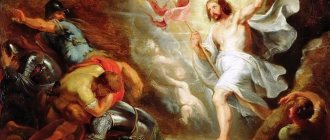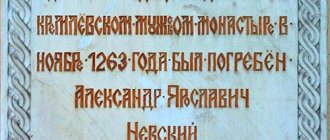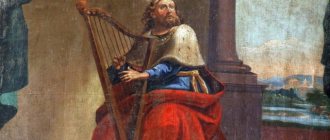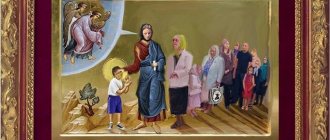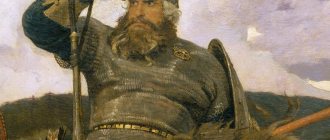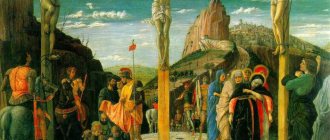Bible Questions and Answers
Published 01/15/2019
Different translations of the Bible say that woman was created from the rib of Adam.
Then the Lord God put the man into a deep sleep and, while he was sleeping, took out one of his rib, and then knitted the man’s skin together in the place from which he took out the rib. The Lord God took a rib taken out from a man, created a woman from it and brought her to the man. The man said: “Finally! She's just like me! Her bone is of my bone, and her flesh of my flesh. She was taken from a man, so I will call her a woman.” (Genesis 2:21-23)
However, the direct meaning of this word in Hebrew is not rib, but “side, side, part.” In addition, the Hebrew root "adm" is used both in the meaning of "man, humanity" and in the meaning of the name "Adam." I have a few questions:
- Why is the word “rib” used in the translation when this is not specified in the original;
- Why is the word "adm" used equally in the sense of "mankind" and "Adam";
- It’s not particularly important to me from which organ a woman was created, but the question of the interchangeability of the words “humanity” and “Adam” matters or is it still not important? For example, adm is a person, aish is a man, ashe is a woman. God created man (adm) in His image; man (adm) named every living creature; there was no suitable helper for Adam (adm); God put man (adm) into deep sleep, etc.
Answer:
“We are at the mercy of stereotypes formed by reading fiction”
First of all, it must be said that the “rib” from which the woman was created should be perceived as a complex image that requires the use of different approaches to be explained. It can be assumed that in primordial man both the masculine and feminine principles were equally present. Saint Innocent of Kherson, for example, writes about this: “A rib or bone here is not something simple. It must mean the whole half of the being separated from Adam during sleep. How this happened, Moses does not say and it is a mystery. What is clear is that first a common organism had to be formed, which then divided into two types: husband and wife.”
It is this co-equality, the same essence of woman and man that the Bible is trying to convey to us, using the image of a rib. But why was this particular image used? And how can we understand whether we are interpreting this mysterious plot correctly? To answer these questions, we will have to take a brief excursion into the specifics of the biblical text itself and try to penetrate the thinking of people of distant antiquity, to reconstruct the cultural context within which they lived.
The fact is that the difficulties of reading the Holy Scriptures are largely due to the fact that today we are at the mercy of stereotypes formed by reading fiction. And this - let us note, beautiful - sphere accustoms us to the fact that the author tries to reveal all the images, characters, events to us as broadly and fully as possible. And if the intention of the work implies that we must perceive something allegorically or speculate, we are already prepared for this either by the words of the author or by the genre of the work itself, that is, we are prepared in advance for a certain approach to the perception of the text. No one will interpret the text of the fable literally.
With the Bible, everything is not so clear. Here side by side are historical narratives that imply a literal understanding, the books of Proverbs or Ecclesiastes, written in an instructive genre, and prophetic books in which the historical account is intertwined with mystical fragments interpreted only figuratively.
The book of Genesis, in terms of the narrative about the creation of the world, in this sense breaks all records for the complexity of drawing the line between the historical and allegorical layers of the text. The creation of the world and man is undoubtedly a historical event, and here we are dealing with a reality accessible to perception. But at the same time, there is also an element of mysterious, intelligible reality.
Firstly, this event is not only historical, but also mystical: God creates the world and man with a certain higher purpose, which does not fit into the framework of exclusively material existence. Secondly, “mystery” is associated with the very decoding of images. It is due to the fact that the prophet Moses, who is the author of the book of Genesis, was forced to convey both physical reality and its mystical, invisible side to his audience in the most understandable language for his time. For example, the holy fathers subsequently did the same, expounding for a pagan audience the truths of the Christian faith in the categories of Greek philosophy familiar to them.
Translation is inaccurate
In 2015, biblical textualist Zaiony Zevit, a professor at the American Jewish University in Bel-Air, California, together with a group of linguists from the founder of the Biblical Archaeological Society in the United States, Herschel Shanks, announced a new reading of this part of the Old Testament chapter.
Scholars argue that the word "rib" in the canonical translations of the Bible does not accurately reflect the Hebrew and Aramaic sources. An error occurred in the texts during translation and census, during which the word meaning stick, bone, was translated as misfortune. While in Hebrew, which did not have the word penis, this very stick-bone was called baculum (animals). Linguists also suggest that the ancient Hebrew word “tsela,” which is usually translated as rib, actually means the foreskin of the penis. At the same time, German scientists specializing in the languages of ancient Sumer also believe that the story of the “rib woman” is an old mistake of translators.
Analyzing the texts of some Sumerian myths in various ancient languages, they came to the conclusion that in the original source the phrase “a woman from a rib who was given life” was translated incorrectly. German historian, anthropologist and linguist, Professor Ragnar Borsheim, argues that the actual reading of this phrase is “a woman for a rib (baculum) giving life.” And although this has to do with pagan Middle Eastern myth, and not with Christian literature, during the writing and subsequent translation of the Old Testament texts, the same words and phrases were used, but their exact meaning was lost.
“Moses uses harsh words tailored to our weakness.”
Helmuts Rudzitis
Very indicative in this sense is the story of the creation of Eve from Adam’s rib. Faced with it, we can rightly wonder whether, in the cultural context in which the chosen people of Israel existed, there were symbols and images that could serve as a key to deciphering this story.
Research and hypotheses of scientists (for example, Assyrologist Jean-Vincent Cheil and Sumerologist Samuel Noah Kramer) make it possible to trace such an influence.
In the Sumerian poem about Dilmun (and the Sumerian civilization had a powerful impact on the culture of the peoples of the Middle Eastern region) there is a plot about how the goddess Ninhursag heals the dying god Enki. During the healing process, Ninhursag creates a special goddess for each of Enki’s eight diseased organs, thanks to which Enki is gradually healed. When Enki, in response to the goddess’s question: “What hurts you?” answers: “My rib,” she says: “For you I gave birth to the goddess Ninti,” which translated means either “the lady of the rib” or “the lady who gives life,” since the Sumerian word “Ti” has both of these meanings. Note that Eve, created from the rib of Adam, is also translated from Hebrew as “life-giver” or, as the Bible says, “mother of all living.”
Although “rib” and “life-giver” sound different in Hebrew, scholars suggest that Moses’ story contains an echo of the ancient myth of Enki and Ninhursag. This does not mean that Moses borrowed Sumerian mythology or was an adherent of it - if only because the Sumerian civilization is separated from the time of the creation of the book of Genesis by about two thousand years, and the narrative of Moses itself is filled with ideas that are absolutely opposite to the religious worldview of the ancient Sumerians. But the very nature of this kind of “borrowing” suggests that Moses uses pagan mythological terminology familiar to his contemporaries to express the divinely revealed truths of monotheism. And let us not be surprised that a certain mythological image through the centuries reached the time of Moses, because we encounter a whole complex of similar motifs - take, for example, the historical memory of the Great Flood, present both in Sumerian mythology and in the Old Testament.
By resorting to the image of a rib, Moses is trying to convey to the people of Israel a very important idea: a woman comes from the being of a man and by nature is one with him.
St. John Chrysostom in his Discourses on the Book of Genesis makes it clear that the story of creation from the rib appears due to human weakness and inability to penetrate the subtle truths of Revelation (“Moses uses harsh words adapted to our weakness”). And what deserves close attention here is the emphasis not on the rib, but on the biological and mental unity of Adam and Eve. One should not attach excessive significance to the story about the rib and see in it any other meaning other than indicating this unity. Otherwise, any anatomy textbook can be used as evidence of the inconsistency of the biblical narrative, whereas we are talking not about errors in the sacred text, but about human inclination to its primitive understanding.
If we use the patristic principle of interpretation, namely: the explanation of Scripture through Scripture itself, we can say that the interpretation of the image of the rib is the words of Adam that the wife is “flesh of my flesh and bone of my bones,” that is, “close, dear.” In those days, this did not sound trivial, since many mythological systems of antiquity thought of a woman as something given by the gods to man from the outside, which in some cases made it possible to treat her as a subhuman, as a very useful and beautiful domestic animal.
The biblical story takes the relationship between husband and wife to a completely different level. Here the woman is a helper, equal to her husband. As the Apostle Paul would later say: Neither is a husband without a wife, nor a wife without a husband (1 Cor 11:11 ). Of course, the Christian gospel raised these relationships to a completely different height, but in the Old Testament, in contrast to the mythological systems of the Ancient East, we see images of women - not goddesses, but earthly historical characters - who show courage, bravery and virtue equal to men (Judith, Esther, Ruth, Jael) and whose role, contrary to gender and cultural stereotypes of the Ancient World, is recognized in the Holy Scriptures.
The Fall of Adam and Eve
God allowed Adam and Eve to eat the fruits of all the trees in the Garden of Eden. With the exception of one thing - the Tree of the Knowledge of Good and Evil. God warned the people that the consequence of breaking this commandment would be death (Gen. 2:16-17). Satan, in the form of a serpent, appeared to Eve and cunningly convinced her to try the fruits of the forbidden tree. The devil told her that by doing this, a person would not only not die, but would become equal to God. Eve succumbed to temptation and transgressed God’s commandment, after which she gave the fruit to Adam to try (Gen. 3:1-6).
All that Adam and Eve felt after their crime was shame before each other and fear of God. They began to cover their naked bodies with leaves and, when they heard the voice of the Creator, they tried to hide from him. The Almighty asked Adam and Eve accusatory questions and expected them to repent, but they began to justify themselves. Adam blamed Eve for the temptation, who, in turn, said that she was tempted by the serpent. By this stubbornness, people only worsened their falling away from God.
"Our positive response to feminism"
EladeManu
This story inspired the holy fathers to deep theological reflections that did not fit into the framework of a flat rational approach. Saint John Chrysostom, for example, draws attention to the fact that after the creation of woman Adam experiences a special spiritual state, and the dream in which he was at the moment of “taking out the rib” is not a dream in the literal sense of the word (just as the rib does not mean a specific organ). After all, his words that Eve is bone from his bones testify to some knowledge that he could not have received if he had really been asleep. Moreover, after this event, Adam is overcome by a prophetic spirit. So, he says: A man will leave his father and mother, be united to his wife, and the two will become one flesh (Gen. 2:24 ). And this is said about subsequent marital unions, although the categories of fatherhood and motherhood are still unknown to Adam.
In the palette of patristic interpretations, a special place is occupied by the testimony of Blessed Augustine, who, in the story of the creation of Eve from the rib of Adam, sees a prophecy about the future unity of Christ and His Church - that is, God and people. There is nothing surprising in this interpretation, since in the Holy Scriptures not only words, but also events can act as prophecies.
For us, Christians of the twenty-first century, this plot, undoubtedly, can become not only an intellectual mystery, but also a source of renewed experience of our own family life. Here is our positive response to feminism, which does not negate the value of women in society, and support in the discussion with those religious movements that, in their perception of the role of women, are not far removed from the pagan mythological systems of antiquity.
Do men have one less rib than women?
Some skeptics have accused the Bible of being wrong here because men and women actually have the same number of ribs. But the Bible never stated otherwise. In fact, this is a very risky mistake because such skeptics do not explicitly accept the completely discredited evolutionary view called Lamarckism.
This was the erroneous view of the pre-Darwinian French evolutionist Jean-Baptiste Lamarck (1744-1829) on the “inheritance of acquired characters.”
His views are false: men who lose a finger do not have sons (or daughters, for that matter) with only nine fingers, because the loss does not affect the DNA instructions for the number of fingers. People with amputated limbs do not have children with similar amputations, and girls are not born with pierced ears.
In fact, the Bible teaches correct science. Later in the book of Genesis, God made a covenant with Abraham. The important part was a specific amputation operation for Abraham and his male offspring after him “throughout all their generations” (17:9-14). It is clear that this amputated part will reappear every generation, refuting Lamarckism. Science sometimes manages to catch up with the Bible.
Ribs can grow back!
Another case where science is catching up with the Bible has to do with the rib itself. Only recently have surgeons discovered that the rib is the only bone in the human body that grows back easily!
That is, as long as the covering membrane, called the periosteum (Greek for “around the bone”), remains intact (the periosteum often gets stuck in the teeth when eating ribs). This is facilitated by the rich blood supply to the attached intercostal ("between the ribs") muscles.
Dr. David Pennington, the first plastic surgeon in the world to successfully reattach a human ear, noted:
“The costal periosteum has a remarkable ability to regenerate bone, perhaps more than any other bone.”

